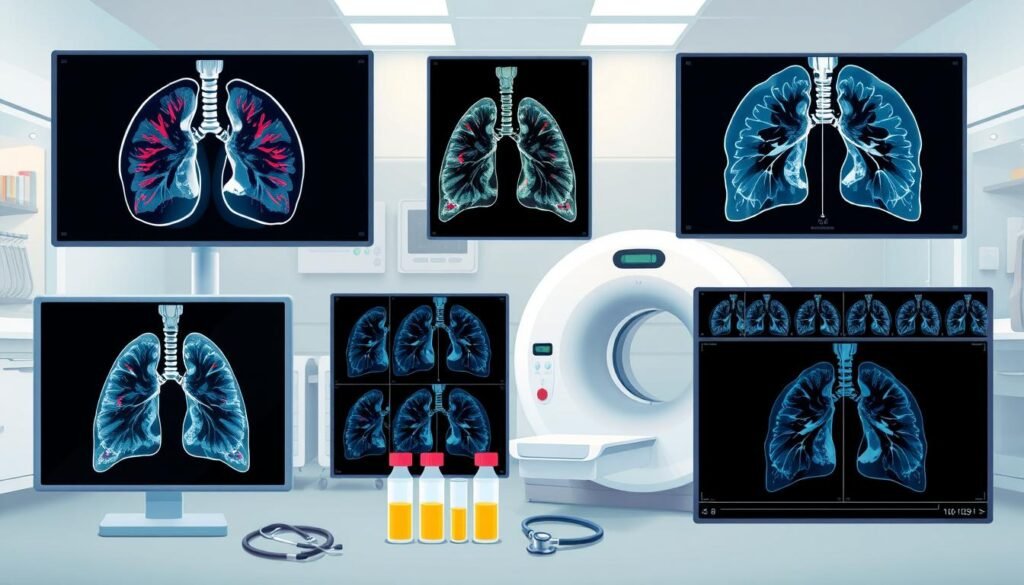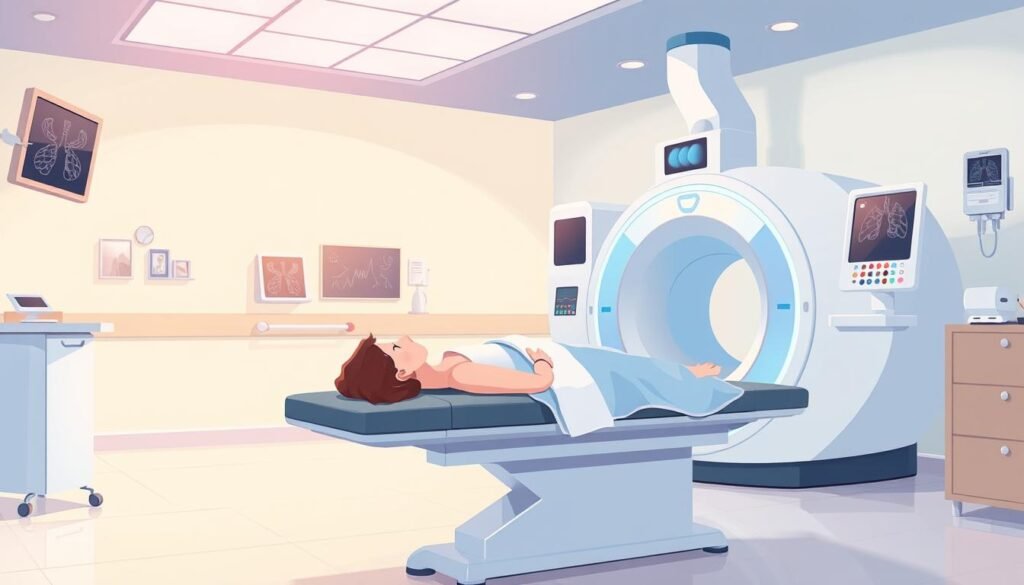Lung cancer staging tells us critical details about the disease. In fact, 30% of cases are found to be advanced when diagnosed. This process of staging helps decide treatments and predicts outcomes. It looks at the tumor’s size, location, and if it has spread.
This article will distinguish between early and advanced lung cancer. Understanding these stages helps improve treatment and survival. Knowing about lung cancer stages makes readers better advocates for their health.
Key Takeaways
- Understanding cancer stages is crucial for effective treatment planning.
- Up to 30% of lung cancer cases are diagnosed at an advanced stage.
- Non-small cell lung cancer is classified into distinct stages affecting prognosis.
- Early-stage lung cancer usually offers better treatment outcomes.
- Staging involves assessing tumor size, lymph node involvement, and metastasis.
Introduction to Lung Cancer Staging
Lung cancer staging is key in figuring out the right cancer treatment planning. It looks at the cancer’s size, its location, and if it has spread. Knowing these details helps doctors make treatment plans that work best for each patient.
Getting lung cancer staging right is super important. It can change how well treatments work. For stage I lung cancer, the tumor is small and hasn’t spread. Here, a simple surgery might help about 80% of patients at MSK Cancer Center.
Stage II lung cancer has bigger tumors or some spread to nearby lymph nodes, but it’s still inside the lung. Stage III lung cancer shows more spread to the lymph nodes, signaling it’s getting worse. Stage IV is the toughest stage, with the cancer spreading to other organs like the brain or bones.
For more details on lung cancer staging, check out this link. Knowing the stages helps in figuring out how to treat the cancer best.
What is Early-Stage Lung Cancer?
Early-stage lung cancer means the disease is still in its initial stages, particularly stages 0 and I. The cancer hasn’t spread far and is mostly in the lungs or close by. This is crucial for deciding on treatment and improving the chances of recovery. Understanding the characteristics of early lung cancer is key to early action and improvement.
Characteristics of Early-Stage Lung Cancer
Some main characteristics of early lung cancer are:
- Smaller tumors, usually under 4 cm.
- Spread is limited, mostly staying within the lung or close lymph nodes.
- Better survival rates, with early stage lung cancer survival between 77% and 93%.
- Effective treatments are available, like surgery and radiation.
Common Types: Non-small Cell and Small Cell Lung Cancer
There are two main types found early on:
- Non-small cell lung cancer (NSCLC): Making up to 85% of all lung cancers, NSCLC generally has a better outlook if found early. Patients might undergo surgery, including cutting-edge options like stereotactic body radiotherapy (SBRT).
- Small cell lung cancer (SCLC): Though rarer and more aggressive, early detection of SCLC matters. Treatment could involve chemotherapy with radiation, particularly for limited disease.
Knowing these types helps tailor effective treatment plans for early-stage lung cancer patients.
| Type of Lung Cancer | Prevalence | Treatment | Survival Rate (Stage 1A) |
|---|---|---|---|
| Non-small cell lung cancer (NSCLC) | 85% of lung cancers | Surgery, SBRT, Radiation | 77% – 93% |
| Small cell lung cancer (SCLC) | Second most common type | Chemotherapy, Radiation | Varies based on stage |
What is Advanced Lung Cancer?
Advanced lung cancer means cancer stages III and IV, where it has grown a lot. It might have spread to places beyond the lungs, like lymph nodes and other organs. Knowing about its severe symptoms can help in managing the disease better.
Characteristics of Advanced Lung Cancer
People with advanced lung cancer can have symptoms like:
- Persistent cough
- Chest pain
- Unexplained weight loss
- Shortness of breath
- Fatigue
As cancer gets worse, it often reaches nearby lymph nodes and far organs. This state might be the first diagnosis or come back after earlier treatments.
Differences Between Non-small Cell and Small Cell Lung Cancer
Advanced NSCLC and SCLC have different traits in the later stages. The main differences are:
| Characteristic | Advanced Non-Small Cell Lung Cancer (NSCLC) | Advanced Small Cell Lung Cancer (SCLC) |
|---|---|---|
| Prevalence | Around 85% of lung cancers | About 15% of lung cancers |
| Growth Rate | Slower growth | Rapid progression |
| Diagnosis Stage | Often diagnosed at a later stage | Typically diagnosed at an advanced stage |
| Treatment Options | Includes surgery, radiation, and systemic therapies | Primarily treated with chemotherapy and radiation |
For advanced lung cancer, fast and right treatment is essential. Knowing the differences helps guide the treatment and support for patients.
Understanding Lung Cancer Stages
Lung cancer stages are key in planning treatment and predicting outcomes. The TNM staging system is the most used method. It looks at tumor features, lymph nodes, and if the cancer has spread to provide a clear patient status.
The TNM Classification System
The TNM system is detailed as follows:
- T shows tumor size and place
- N checks lymph node involvement
- M tells if there’s metastasis
Doctors assign numbers from 0 to 4 to describe lung cancer’s severity. Bigger numbers mean the disease is more advanced.
Staging for Non-small Cell Lung Cancer
Non-small cell lung cancer has stages from occult to IV. Each stage marks a different spread level:
| Stage | Description |
|---|---|
| Occult | Cancer is there but not seen. |
| Stage 0 | Cancer cells stay in the lung lining, not spread. |
| Stage I | Tumor stays within the lung. |
| Stage II | Cancer reaches close lymph nodes. |
| Stage III | More lymph nodes have cancer, maybe in both lungs. |
| Stage IV | Cancer spreads to other organs. |
Staging for Small Cell Lung Cancer
Stages for small cell lung cancer are mainly limited or extensive. Limited means cancer is only in one lung and close nodes. Extensive means cancer has moved beyond, to other lung parts or organs. This staging helps pick the best treatment.
Knowing these stages helps doctors plan specific treatments. For more info, click Cleveland Clinic.
Early vs. Advanced Lung Cancer: Key Differences
Knowing how early-stage and advanced lung cancer differ is key. It helps in spotting symptoms early and getting help. Symptoms of early lung cancer might be mild, making them easy to miss. But, symptoms of advanced lung cancer are more serious and greatly impact life quality.
Symptoms of Early-Stage Lung Cancer
Early lung cancer can have mild and unclear symptoms. These sign include:
- Mild cough or changes in cough patterns
- Subtle fatigue or lack of energy
- Slight breathlessness or wheezing
- Unexplained weight loss might be present
These signs are often ignored, causing delays in getting diagnosed. This can limit the treatment choices.
Symptoms of Advanced Lung Cancer
When lung cancer gets worse, the symptoms become more obvious and worrying. Symptoms of advanced lung cancer can be:
- Persistent, severe coughing that doesn’t get better
- Chest pain that worsens with deep breaths or coughing
- Quick and notable weight loss
- Shortness of breath making everyday activities hard
- Coughing up blood, needing quick doctor visit
Spotting these symptoms early is crucial for better treatment outcomes. Knowing the difference in symptoms between early and late-stage lung cancer can help people fight for their health better.
| Symptom Type | Early-Stage Lung Cancer Symptoms | Advanced Lung Cancer Symptoms |
|---|---|---|
| Cough | Minor cough or changes | Persistent and severe cough |
| Chest Pain | Mild discomfort | Intense chest pain worsening with deep breaths |
| Fatigue | Slight fatigue | Severe fatigue affecting daily routines |
| Weight Loss | Unexplained weight loss | Significant weight loss |
| Breathlessness | Subtle breathlessness | Severe breathlessness limiting activity |
Diagnosis and Staging Process
Starting to understand lung cancer begins with a detailed diagnosis process. This involves many key steps. Finding the cancer early can make treatments work better. So, knowing the correct stage of the cancer is very important. This helps doctors plan the best treatment.
Imaging Tests and Biopsies
Imaging tests are crucial in finding out if someone has lung cancer and how far it has spread. There are several key types:
- CT scans – These scans show clear pictures of the chest and can spot tumors.
- PET scans – These scans can show if the cancer has spread by looking at tissue activity.
- X-rays – Often the first test done, they’re good for early checks.
After these tests, doctors do biopsies to learn more about the cancer cells. Using both imaging and biopsy results, doctors can make a good treatment plan.
The Importance of Accurate Staging
Getting the stage right is key for deciding on treatment and knowing the outlook. It’s vital to know if the lung cancer is in its early stages, like Stage 0 or I, or in later stages like Stage III or IV. Each stage tells us about the tumor size and if it has spread.
| Stage | Characteristics |
|---|---|
| 0 | Carcinoma in-situ; cancer stays within the lung lining. |
| I | Small tumors, not reached lymph nodes, has two sub-stages 1A and 1B. |
| II | Bigger tumors that might have reached close lymph nodes. |
| III | Tumors are near chest lymph nodes but haven’t spread far. |
| IV | Cancer has spread wide to distant organs and tissues. |
This method helps doctors give right treatments based on the patient’s specific situation. This way, treatment matches what the patient really needs for a better recovery chance.

Treatment Options for Early-Stage Lung Cancer
There are key ways to treat early-stage lung cancer that help patients live better. Surgery is often the main choice, and sometimes it’s paired with radiation. This combo zaps away any leftover cancer cells. The type of treatment you get depends a lot on the cancer’s stage.
Common Treatments: Surgery and Radiation
Surgery is a big way to fight lung cancer. Doctors may remove a part or a section of the lung. For stage 0 non-small cell lung cancer, surgery might be all you need. Sometimes, doctors use light therapy or lasers instead of cutting.
Stage I lung cancer usually means surgery is up first. Radiation might come later to keep cancer from coming back. Radiation is extra helpful if the tumor was big or if surgery didn’t get it all.
Role of Chemotherapy and Targeted Therapy
Chemotherapy is more common for later stages but sometimes it’s used early on. It can help stop the cancer from returning, especially in stage I. There are also new drugs that target cancer more precisely. Drugs like alectinib and osimertinib are changing the game.
Using different treatments together works better for patients. This way, people have a higher chance of beating cancer. As science moves forward, these treatments keep getting better, fitting each patient’s specific needs.
Treatment Options for Advanced Lung Cancer
Treating advanced lung cancer takes a well-rounded approach, using different methods. Doctors mix treatments to help patients most effectively. This method aims to improve lives of those with the condition.
Combination Treatments: Chemotherapy, Radiation, and Immunotherapy
Treatment for advanced lung cancer often includes chemotherapy, radiation, and immunotherapy together. Chemotherapy is a key part of therapy, given through IV or pills. It’s done in cycles over time.
Radiation helps ease symptoms and targets tumors directly. Immunotherapy, a new treatment, boosts the body’s defense against cancer cells. KEYTRUDA is one such medication, used after surgery or when surgery isn’t an option. Each treatment is critical to tailored care plans for patients.
New Treatment Advances in Advanced Lung Cancer
Recent progress offers treatments targeting genetic changes like KRAS mutations. These therapies aim to better survival rates and life quality. Researchers are working on fine-tuning these therapies. Their goal is to create personalized, more effective treatment strategies for lung cancer patients.

| Treatment Type | Description | Potential Side Effects |
|---|---|---|
| Chemotherapy | Involves drug therapy to kill cancer cells and reduce tumor size. | Nausea, hair loss, fatigue, increased risk of infections. |
| Radiation Therapy | Uses high-energy particles to target and kill cancer cells. | Skin irritation, fatigue, difficulty swallowing. |
| Immunotherapy | Stimulates the immune system to attack cancer cells. | Fatigue, rash, diarrhea, fever. |
| Targeted Therapy | Focuses on specific genetic mutations to inhibit cancer growth. | Varies based on drug; may include liver complications, rash. |
Prognosis for Early-Stage vs. Advanced Lung Cancer
The outlook for lung cancer depends heavily on the stage at diagnosis. Early-stage lung cancer generally means a better chance at surviving long-term. Those with advanced cancer face tougher odds. Knowing the difference helps patients and families choose the right treatment path.
Understanding Survival Rates
Survival rates for early-stage lung cancer highlight the variations in prognosis. Approximately 65 out of 100 people with stage 1 non-small cell lung cancer may live five years or longer. But as lung cancer progresses to stage 2, the survival rate falls to about 40 out of 100.
The situation becomes more challenging at stages 3 and 4. Here, survival rates dip to 15 out of 100 and 5 out of 100 respectively. For advanced stages, the five-year survival rate drops significantly. Only about 16% of patients live five years or more after being diagnosed late.
The Role of Individual Factors in Prognosis
Many personal factors impact the prognosis of lung cancer. These include the patient’s age, overall health, and existing conditions like heart problems. People in good health tend to do better with treatments and surgeries. This boosts their chances of surviving early-stage cancer.
Women often have a slightly brighter outlook than men with the same diagnosis. Significant weight loss before treatment can worsen the prognosis. Genetic mutations in the cancer cells also play a role. They can determine how well the cancer reacts to certain treatments.
Lung Cancer Screening and Early Detection
Lung cancer screening is key to improving survival rates. It helps find the disease early, which is crucial. People who have smoked for a long time should get yearly low-dose CT scans. These scans are recommended by lung cancer screening guidelines for the best results.
Importance of Regular Screening
Early detection of lung cancer is very important. Sadly, only 21% of lung cancers are found when they’re still localized. This highlights the need to take action for our health. Getting checked every year with low-dose CT scans can cut down the death rates from lung cancer. This screening finds cancer early, making treatments more likely to work.
Screening Guidelines for High-Risk Individuals
The guidelines aim to help people at high risk. The US Preventive Services Task Force suggests yearly scans for 50 to 80-year-olds with a 20 pack-year smoking history. This is for those who still smoke or quit in the past 15 years. The National Comprehensive Cancer Network® and the American College of Chest Physicians advise the same.
Screening has big benefits but also some drawbacks. There’s the radiation risk and the cost for some people. Talking with healthcare providers helps in making the right decision together.

Conclusion
Knowing the stages of lung cancer is vital for informed health decisions. Early and late stages of lung cancer really affect what treatments can be chosen and how well people might recover. Early-stage lung cancer has a better chance of survival, with a 63% chance of living for at least five years.
However, for those with advanced lung cancer, the survival rate drops to just 8%. This shows how important early detection and proper staging are. They help in getting better results for patients.
When patients learn the signs, like a bad cough or losing weight without trying, they can talk to doctors early. Following screening recommendations is also key. Even though only 16% of people who should get screened do so, screenings can cut the death rate by 20% and save many lives.
Lung cancer impacts a lot of people in the United States. Knowing its risks and signs can help catch it early. With over 234,000 new cases expected in 2024, it’s important to understand lung cancer stages. This way, patients can choose the best treatment options and have a better chance at a good outcome.